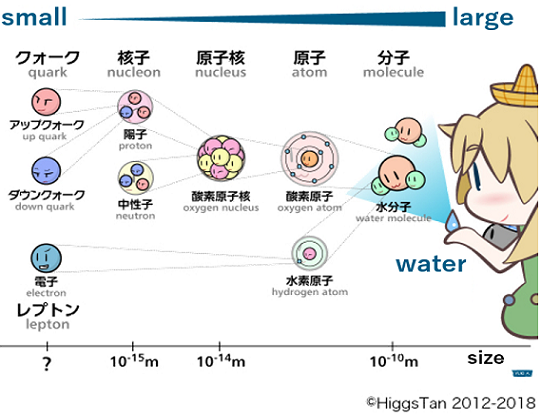All matter is made of molecules such as Hydrogen and Carbon. A molecule is made of a combination of atoms, each of which is made of a nucleus and electrons. Thus, the nucleus is made of tiny particles (protons, neutrons). In this way, you can trace back to the smallest component of matter, an elementary particle. High energy physics is a study to solve the mechanism of elementary particles and the physics lows through experiments using a huge “microscope” and accelerators.
Nowadays it is known that protons and neutrons that make nucleus are made of smaller particles called quark. Within the experimental resolution, the size of elementary particles such as an electron, neutrino, and quark are less than 10-16m. If an atom were the size of a baseball field, an elementary particle would be as small as a ping-pong ball. To examine such a tiny world, we need to use high-resolution microscopes. At present, some microscopes use not only light but also particles, and these can approach the secret of the microscopic world on the scale of elementary particles!! We call the ultimate “microscope” a particle accelerator or accelerator. In experiments with the accelerator, we examine a collision reaction in which particles, such as electrons and protons, are hit with high energy, and try to see the internal structure of the particles. It is like colliding two clocks and breaking them, observing the parts. That is why an experimental physics of elementary particles is called High energy physics.

What does “high energy” mean? How much energy is needed?
A well-known unit of energy is a calorie. The amount is required to raise the temperature of 1 gram of water through 1 °C. If you convert calorie to electronvolt, the amount of kinetic energy which an electron gets after it is accelerated by 1 volt of electricity, 1 cal = 2.6 × 1019 eV. One gram of water contains many water molecules so that each molecule gets only 10-3 eV. The energy of phenomena in our everyday life is large, but that of each particle, which consists of matter, is small. While much more energy, such as 10 GeV ~ 1 TeV, is required for each particle that causes a collision to research the elementary particle world!

In the experiences of colliding high-energy particles, we can search not only the microstructure of matter but also another phenomenon. One of the findings of Einstein’s theory of relativity is “energy = mass * (speed of light squared).” Energy and mass are equivalent. That is, various particles are newly generated from high energy state that made by collision.
The left figure shows a state immediately after high-energy particles collide. It shows two particles flying from the front and back of the screen collide in the middle of the figure, generating particles marked with red curves and green lines.
In the early universe immediately after the Big Bang, it is believed that all matters existing around us were confined at a tiny region and were extremely high-temperature state (high energy density). High energy particle collision reactions frequently occurred like the picture above and generated massive elementary particles. These particles do not exist in the current universe. However, in the high energy particle collision experiment, we can make and research these elementary particles that existed in the early universe.
In high energy physics experiments, the bunch of particles such as an electron or proton is accelerated by accelerators and becomes a high energy particle beam. This beam is lead to the collision point and causes a collision reaction. To catch the particles which are generated in the collision, particle detectors are set around the collision point. We can measure and analyze signals from the detectors using high-speed electronics and computers.